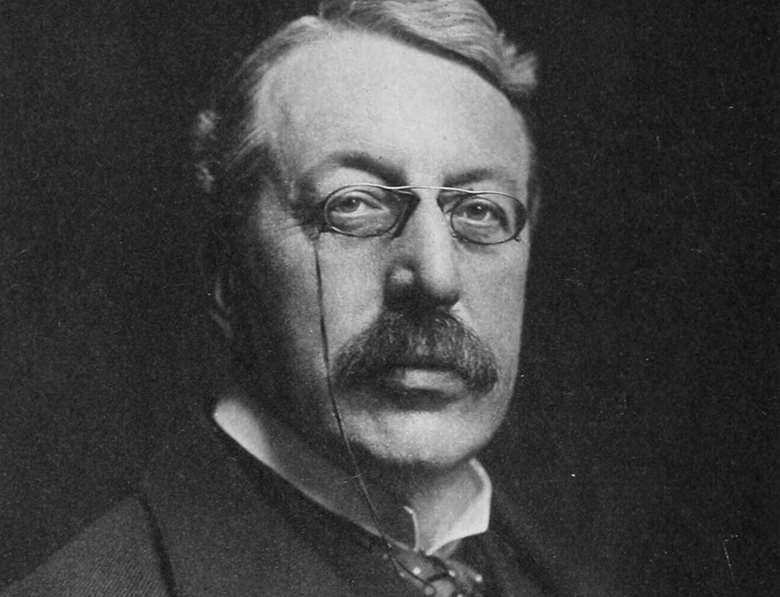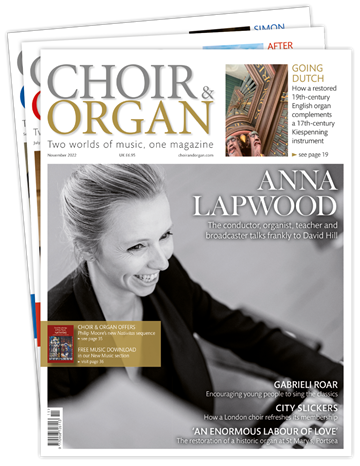The choral music of Charles Villiers Stanford
Jeremy Dibble
Friday, February 23, 2024
As we mark the centenary of Charles Villiers Stanford’s death, Jeremy Dibble explores the choral music and the lesser-known works which have seen recent revival and recording

Today we quite rightly venerate the church music of Charles Villiers Stanford. It is without doubt among the most original liturgical creations of its era, and in conceptual terms, surely surpasses even the great motets of Brahms, Bruckner, Cornelius and Reger in its sheer brilliance of symphonicism, formal dexterity and functionality. Yet we have still to discover Stanford’s extraordinary versatility as a composer of choral music for the concert hall and choral festival. Looking beyond those works which have established themselves in the repertoire, works engendered by a life of choral training and conducting, fostered in the Dublin cathedrals of Christ Church and St Patricks, but lived out to the full through the agencies of Trinity College Chapel, Cambridge, the Cambridge University Musical Society (CUMS), the Royal College of Music, the London Bach Choir, the Leeds Philharmonic and the Leeds Triennial Festival.
Almost certainly Stanford’s two most popular choral works today are his two cycles of five orchestral songs with words by Henry Newbolt, The Songs of the Sea, (the first of which, ‘Drake’s Drum’, has become a classic) and its sequel, and arguably more profound, The Songs of the Fleet. Both were written for Stanford’s friend and Irish compatriot, Harry Plunket Greene, and the Leeds Festival where Stanford was artistic director between 1901 and 1910. These two five-song cycles are most frequently performed separately, but they can be performed together, particularly since the final song of Songs of the Fleet, ‘Fare Well’, a most affecting ‘Envoi’, makes reference in its dramatic coda, to the last song, ‘The Old Superb’, of Songs of the Sea. Stanford’s partiality to Britain’s naval heritage is also evident in his setting of Tennyson’s The Revenge (1886). This was immensely popular during Stanford’s lifetime, not only because of its patriotic spirit, but because it used a narrative model for chorus and orchestra where the swash-buckling ‘story’ was conveyed by the voices and the drama (often, and in keeping with Stanford’s theatrical leanings, operatic in demeanour) by the orchestra. A second setting, of Thomas Campbell’s The Battle of the Baltic (1891), used the same narrative template, but was less successful. On the other, Phaudrig Crohoore (1895),a further narrative, this time in the form of an ‘Irish Ballad’, enjoyed a vogue in the 1890s with its characteristic Hiberno-English (in a libretto provided by Sheridan Le Fanu, known for his chilling ghost stories and horror fiction) at the same time as Stanford’s enormous operatic success with Shamus O’Brien (1896).
The eminently pragmatic, choro-centric dimension of The Revenge (which obviated the expense of soloists) did not, however, extend to the much neglected setting of Bishop Heber’s poem The Lord of Might Op 83, commissioned by the 1903 Festival of the Sons of the Clergy. Styled a ‘motet’, perhaps owing to its neo-Baroque allusions. This work deserves to be sung more often but is only available in the form of Novello’s published vocal score. By comparison, however, Song to the Soul, a fusion of two of Stanford’s settings of Walt Whitman’s poetry Op 97 for chorus and orchestra (‘Darest thou now, O Soul’ and ‘Joy, shipmate, joy!’), and a work the composer deeply valued, was to suffer a more luckless fate. Composed with an eye on an American east-coast tour and a performance at the Norfolk Festival in Connecticut, it was turned down (probably for practical reasons), shelved and remained unperformed at Stanford’s death.
Song to the Soul is a fine example of the sheer variety of Stanford’s shorter choral works which begins with the early but highly uplifting setting of Klopstock’s ‘Osterlied’ (which Mahler later used in his Second Symphony), published as The Resurrection (or Die Auferstehung), written when he was a private student in Leipzig in 1874 and revised in 1876. Others include his entertaining Cavalier Songs Op 17, settings of Browning’s poems for baritone and male-voice choir, O Praise the Lord of Heaven Op 27, a pièce d’occasion written for the Royal Jubilee Exhibition in Manchester in 1887 (the full score is lost), East to West Op 52, written for the Chicago Exhibition of 1893 with words by Swinburne, and The Last Post Op 75, composed during the Boer War to a poem by W. E. Henley and containing parts for bugles. Of a similar commemorative nature (and based on a comparable ternary march structure of great solemnity) is the unique At the Abbey Gate Op 177, inspired by the interment of the Unknown Warrior in October 1920. Here the outer sections of the march are consigned to the orchestra alone, leaving the dialogue for chorus and soloist to be enacted in the extended central ‘trio’. As a counterbalance to the male-orientated scoring of the Songs of the Sea and the Cavalier Songs, the three ravishing ‘idylls’ of Fairy Day Op 131 (1913) were conceived for female chorus and small orchestra. Dedicated to Victor Harris and the St Cecilia Society of New York, the triptych of miniatures using words by another compatriot Irishman, William Allingham, shows Stanford at his most pointillistic in terms of its delicate orchestral garb and vocal scoring.

Cover of Stanford’s choral work Phaudrig Crohoore, composed in 1896
The innate symphonic mindset and sense of diversity which instinctively inhabits Stanford’s shorter choral works can also be observed with equivalent panache in his large-scale canvases. His two oratorios, both written for Birmingham, are now ripe for rediscovery. The Three Holy Children Op 22(1885), taken from the Book of Daniel and Psalm 148, recounts the biblical epic of Shadrach, Meshach, and Abednego as they are saved from the ‘burning fiery furnace’. A powerful drama, heard by the young Elgar (and which appears potentially to have influenced his own oratorios, not least The Dream of Gerontius), has all the ingredients of an opéra-manquée. Entirely different in content and more ambitious in concept, Eden Op 40 (1891), is more original in its combination of modality and advanced harmony. Based on a bespoke libretto by Robert Bridges (who drew inspiration from Milton’s Paradise Lost and Paradise Regained), it has been entirely neglected, yet it occupies a vital position in the evolution of pre-Elgarian experimental British oratorical forms, not least in the vivid role of the orchestra and the large array of soloists.
The Wagnerian aspect of both of Stanford’s oratorios – primed by the staging of his two operas in Hanover in 1881 (The Veiled Prophet) and Hamburg (Savonarola) in 1884 – was anticipated in the pioneering setting of Whitman’s burial hymn for President Lincoln (it predates by some way the more famous settings of Whitman by Delius, Vaughan Williams, Charles Wood, Holst, Harty and Bliss). Recently recorded for the first time by the BBC National Orchestra and Chorus of Wales, under Adrian Partington, the Elegiac Ode Op 21 (1884), a passionate four-movement essay written for the Norwich Festival, has all the properties of a symphony in the cyclic integration of its first movement and finale, the latter of which remains one of the composer’s most impressive epilogues, as well as its ‘dance’ for solo soprano and hot-blooded, almost ‘Tristanesque’, outpouring for solo baritone. Whitman was one potent source of poetical stimulation for Stanford; another was his beloved Tennyson who not only prompted the creation of The Revenge but also The Voyage of Maeldune Op 34 (1889), an extended ballad also performed at Leeds. Essentially a choral ‘odyssey’ and loosely founded on the Irish 11th-century Romance, it depicts the adventures of the central character, the wandering chieftain (played by an ‘heroic’ tenor), and his visits to strange exotic islands. In this context the chorus take on an exciting range of roles, from Greek-style reflection to characterful turba (‘crowd’), though as with so many Stanford choral works, it incorporates a stunning interlude for orchestra, this time in the guise of a scherzo (to rival that of Berlioz’s ‘Queen Mab’).
Three of Stanford’s major choral works, all conceived for chorus, orchestra and four soloists, require less introduction. His Requiem Op 63, performed at Birmingham in 1897, lately issued in a superb recording, ranks among his greatest achievements. Dedicated to the memory of his friend, the painter Lord Leighton, its conspicuously, Italianate countenance (though more sober than the ‘blood and thunder’ of Verdi who greatly admired Stanford’s work) can be felt in the ‘Dies Irae’ sequence and the visionary ‘Agnus Dei’ and ‘Lux Aeterna’, conceived together as an imposing and deeply moving funeral march.
Even more operatic than the Requiem, the Stabat Mater Op 96, composed for the 1907 Leeds Festival, not only contains some of his most memorable and characteristic material, but its intricate matrix of two purely orchestral movements (an overture and intermezzo) and three vocal paragraphs seems to extend beyond its description as a ‘symphonic cantata’ into a work that elusively occupies a position between stage and concert hall. Less well known (but also recently recorded by the BBC National Orchestra of Wales) is the Te Deum Op 66 (1898). Also written for Leeds, and dedicated to Queen Victoria on the occasion of her Diamond Jubilee, it was very much a creation perfectly suited to the majestic proportions of the festival’s legendary 450 voices, and any choir willing to explore this challenging score will be thrilled by its sumptuous eight-part textures and the acuity of its choral savoir faire. This leaves the much later, and largely unfamiliar setting of the Latin mass, ‘Via Victrix’ Op 173 of 1919 (not to be confused with the shorter liturgical Mass in G Op 46 commissioned by Thomas Wingham of the Brompton Oratory in 1891), which Stanford never heard in its entirety during his lifetime. Although published in vocal score by Boosey, the lack of orchestral materials nevertheless militated against its performance until its world premiere by the BBC National Ochestra of Wales in October 2018.
Recently performed by the enterprising Lincoln Choral Society, ‘Via Victrix’ stands as a mighty codicil to a rich and rewarding legacy which, like that of Parry’s choral output, is now enjoying something of a revival and reassessment. Indeed, as we celebrate the centenary of the composer’s death this year, the imperative to explore this treasure trove of highly varied and imaginative choral utterances has never been greater.
Jeremy Dibble is Emeritus Professor of Music at Durham University. A revised and expanded edition of Charles Villiers Stanford: Man and Musician is out on Boydell and Brewer in April
This article originally appeared in the Spring 2024 issue of Choir & Organ magazine. Never miss an issue – subscribe today








